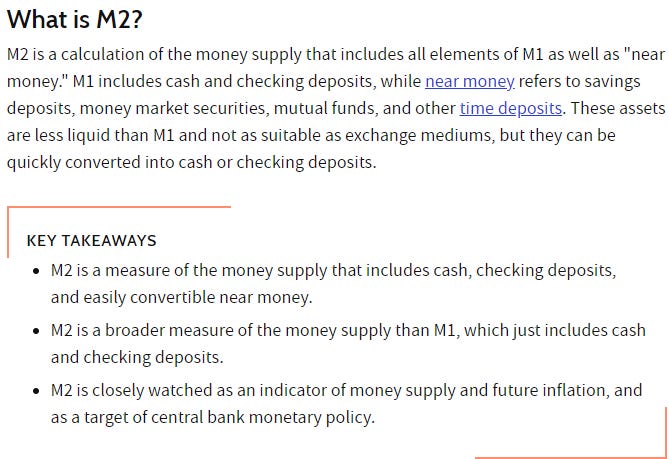On November 5th, 2021 a new 1 trillion dollar infrastructure bill was passed. There are many things to be watching for as the government starts to intervene with brute monetary injection of capital into the system. If you hold assets, this is definitely a plus for you, but if you do not own a house, stocks, crypto, or commodities – then you are an involuntary victim of what the government is doing to the lives of American people.
You may be thinking, “why does it not affect those who hold assets?”
Simply put, those who hold assets are going to become richer and richer as more capital flows into the system. More on that later. For now, let’s start with supply and demand.
(Investopedia) (Look at the chart vertically not diagonal)
Disclaimer: Before you read the rest of the article, it is important you understand this concept. If you don’t, the rest of this article is not going to make much sense.
To keep things easy, I have included this chart to understand the concept of asset classes and supply and demand. There is a reason why people have been investing for the longer term, but I hope this gives you an idea on why everything is getting more expensive. You may have seen homes, groceries, gas, rent, and other things start to rise in price around you. So now looking back at this chart you’ll have a reference. This chart is simply stating that if there is no supply then the demand for a particular object is very high – if that demand is high then the price will go up because it is sought out. The opposite is also true because if there’s so much supply then the demand for that particular object starts to dwindle – pretty much leaving it priceless.
Going back to those who do not hold any assets. Their money isn’t tied to anything so therefore there’s no growth on their money overtime. So as new money gets injected in the system – everything around them starts to increase and their dollar seems like it’s staying the same. They’re being robbed without them knowing. Majority of those people in the bottom 50% barely hold any assets, while the top 90-100% hold the majority of assets. So as the asset prices get inflated by new dollars, the bottom 50% start to lose out and are basically locked out of the system.
So now that you have this concept, let me briefly discuss the asset classes in relation to the US Dollar.
Stocks:
(Finviz.com)
You may recognize two powerhouse technology stocks in this table. It’s very important to note the difference in SHARE FLOAT and SHARE Price. Tesla is shy of 1 Billion shares out, and of that amount of shares – only 788.12 million share are available for the public to hold at any given time. Apple on the other hand is shy of 16.5 Billion shares with 16.39 Billion available for the public. Now if you’re trying to understand why Tesla costs more – it’s because there’s only 788 Million Shares for the whole world to grab versus the 16.5 billion shares that Apple has. This also explains volatility in each stock, but I will not be talking about that here. So if we go back to supply and demand, there’s really not much of Tesla for all of world to grab. This means that people will ultimately have to pay a higher price for these stocks as more money flows into the market. Those that hold stock, as money gets injected into the system, will eventually see gains in their account because stocks are considered an asset. If there’s a limited supply of stock and the supply of money increases – then the demand for assets will go up to offset the inflation that hits the market.
However, that isn’t all.
You can see this in cryptocurrency, real estate, and commodities markets. Anything that has a limited supply eventually starts to grow in price because the reserve currency of the world has to reprice assets in relation to the monetary supply. So now let me introduce you to the Monetary Supply (M2).
(FRED) Board of Governors of the Federal Reserve System (US), M2 [M2SL], retrieved from FRED, Federal Reserve Bank of St. Louis; https://fred.stlouisfed.org/series/M2SL, November 9, 2021
In this chart, you can see the graph start to skew upwards after 2008. During this time Quantitative Easing was introduced and increased the monetary supply by 500 billion dollars. That 500 Billion dollars started to spiral out of control as asset prices started to increase. Since there’s more money in the system that is available for everyone – the credit system started to print more money in addition to what is already put into the system. How is that possible?
For simple math, let’s take the 500 billion from 2008 as an example. 500 Billion is injected into the monetary supply, but let’s say it’s being loaned out as a student loan (shameless plug) and let’s say people have to pay 10 percent interest. Which means that 25 Billion is now owed back to in interest so now theoretically there’s 525 Billion dollars in circulation per say.
If you asked the question “But there’s only 500 billion dollars that was printed… how is that possible?”
Then you got the correct answer. It cannot be paid back. It literally forms as a spiral of debt. That debt overtime starts to compound. Asset prices from that debt is inflation and that eventually makes everything more expensive by default.
So going back to the chart, you can see that Inflation started to slowly melt upwards. However, after 2020 you can see the monetary supply go parabolic. Everything around you is definitely worth more than it was a year ago or even in 2019. There’s always an after effect for anything that is introduced into the system.
Now is temporarily holding Fiat (money that isn’t backed by anything) currency a bad thing? No. Temporarily holding Fiat currency is a strategy for those who know how to use the dollar to it’s maximum potential; however, many will learn this skill too late in life. There’s nothing wrong with holding dollars if it’s temporary, but in the long run – the value of the dollar will continue to diminish. Those that continue to wait on the sidelines will see their net worth start to slowly diminish. What was once 1 dollar will become pennies, and at that point we’re bound to repeat history – Rome, Germany, and Venezuela (collapse of currencies).
Retire By Investing is on a mission to help others increase their free time through financial education. This substack does not provide financial advice of any kind. We do not sell or manage financial investments or vehicles. We are not licensed individuals and are not liable for any financial decisions you make. Please do your own due diligence and consult/seek your financial advisor regarding any decisions. Thank you. Have a great day!
Join us on our journey to help others by subscribing below!
If you liked this post from Retire By Investing, why not share it?
Thumbnail Pictures Provided By These Artists on Pexels.



















Share this post